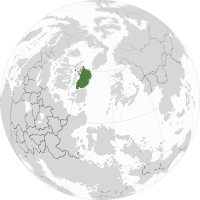Laifelais

| |||||||

| |||||||

Location of Laifelais (green) | |||||||
| General Information | |||||||
|---|---|---|---|---|---|---|---|
| Official Name | Concordant Consortiums of Laifelais | ||||||
| Common Name | Laifelais | ||||||
| Demonym | Laifelish | ||||||
| Capital | Aistana | ||||||
| Largest City | Ancalë | ||||||
| Official Language(s) | Taróma, Laifelish | ||||||
| Species | 92.2% Nórë 5.6% Human 2.2% Others | ||||||
| Ethnic Groups | 93.5% Laifelish 3.2% Sowish 1.4% Xet 1.2% Agimanians 0.7% Others | ||||||
| Religion |
| ||||||
| Government | |||||||
| Government Type | Unitary parliamentary theocratic Eruist republic under an authoritarian government | ||||||
| High Consort | Cala Elara | ||||||
| Grand Custodian | Tuor Aran | ||||||
| Legislature | |||||||
| Legislature | Concordant Assembly | ||||||
| Formation | |||||||
| Eruite Revolution | 1054 | ||||||
| Geography | |||||||
| Continent | Legexet, Agiman (Overseas Territories) | ||||||
| Region | - | ||||||
| Area (km²) | - | ||||||
| Area (mi²) | - | ||||||
| % Water | - | ||||||
| Borders | N/A | ||||||
| Population | |||||||
| Population | 48,859,865 | ||||||
| Census Year | 1125 | ||||||
| Density (/km²) | - | ||||||
| Economy | |||||||
| Currency | Laifelish Mihta (մ) (LFM) | ||||||
| GDP (PPP) | $2.13 trillion | ||||||
| GDP per capita (PPP) | $43,615 | ||||||
| GDP (Nominal) | $1.54 trillion | ||||||
| GDP per capita (Nominal) | $31,583 | ||||||
| Gini Coefficient | .48 (1125) — medium inequality | ||||||
| HDI | 0.882 (1125) – very high | ||||||
| Other | |||||||
| Date format | YYYY/MM/DD | ||||||
| Internet TLD | .lf | ||||||
| Driving side | right | ||||||
| Calling Code | +43 | ||||||
Laifelais, officially the Concordant Consortiums of Laifelais, is a country located in X region, eastern Legexet. Though it shares no land borders with any nation, its mainland shares a maritime border with Sow to the west and south, Yigó to the northwest, Xet to the north, and Krukyr to the east. Its overseas territories consist of X, Y, Z, and A. It has a total land area of X square kilometers and is the Xth largest country in Legexet. Laifelais is a Eruist theocratic republic, and is divided into 7 regional Domains that act as administrative regions with 71 Consortiums as the nation's second-level subdivisions. Its capital of Aistana is the national administrative center and the religious center of Eruism. The largest city, Ancalë, is the economic and cultural center and is the former capital city before it was moved to Aistana in 1060.
The first known settlements on the island of Laifelais were found in the southern coastal regions on what is now the Domain of Airon, dating back to the Palaeolithic Era. The inhabitants of the island would first introduce agriculture to the southern river valleys. The early inhabitants of the island would also be one of the first centers of the global chalcolithic period as copper production was found earlier compared to its region. By the time of the First Wave of human inhabitants arrived to the world, the Nórë would quickly elevate to the Bronze Age as they adopted the bronzemaking knowledge of humanity, thus forming the first of the Laifelish bronze age societies on the island. The later collapse of the bronze age and the transition to the Iron Age would see the rise of the ancient cities of Arnen and Ancalë. The Age of Antiquity would see the rise of Arnen as a highly influential city-state in the region, becoming the Arnen Dominion and dominating the island and its surrounding regions for years to come. The medieval era would see the rise of petty kingdoms in the wake of the Dominion's collapse, giving rise to early feudal polities on the island. With the legendary conquests of Arwen of Ancalë, the petty kingdoms would soon be conquered and the entirety of the island united under the era of the High Kingdom that would span for much of the medieval age, leading to a period of stability and power that saw medieval Laifelais expand its influence over much of its surrounding regions. The Temple of Eru would also gain considerable influence and power in this time. With the coming of the Second Wave of humans to the world, the disproportionate technological difference between the medieval Laifelais caused the downfall of the High Kingdom as the several wars incurred upon them pushed the kingdom to a breaking point. A rising societal group known as the Enlightened would quickly gain influence and, alongside the Eruist Temple, would launch a revolution in 1054 in response to the monarchy's opposition to modernization and the widespread imposition of secularization of the Kingdom led to the toppling of the monarchy and install a new technologically reformist theocratic republic under the authoritarian rulership of the Temple.
The deposition of High King Nuvian II and the Laifelish royal family during the Eruite Revolution and the ascension of Eruite rule can be attributed to the rise in influence of the Enlighteneds and the growing opposition power of the Temple of Eru. Though differences in their goals were present, they were able to establish a united front to oust the royal family from power. Many of the ideological liberals equally opposed the rising religious revolutionaries, but were not able to garner much support due to the public disdain of human ideologies on top of Laifelish society being largely religious and traditional. After the revolution, Laifelais' political structure was thoroughly reformed to remove any semblance of church and state separation whilst retaining a nominally republican form of government with an established constitution. Unity within the Revolutionary Front was put into question after the revolution, with fears of schism and nascent royalist counterrevolutionaries threatening to tear down the revolution from the inside. Nevertheless, the purges of subversive movements over the years gradually quelled these fledgling rebellions and further consolidated the power of the High Consort and the ruling government. Military involvements such as the conflicts with Sow, the Agiman conflicts, and more recently the war against Kubonic states had shape Laifelais' standing in the region in every conflict.
As it stands, Laifelais is an Eruist theocratic republic with some semblance of democracy in some governmental institutions, with only the block-voted councils in each Consortium being directly elected by the populace, which in turn elects the members of the Concordant Assembly as part of an indirect voting system from the populace. Laifelais is well regarded as an authoritarian state with systemic corruption, poor species rights record, restriction on several freedoms and rights, and lack of upholding democratic principles being its major factors of criticism and scrutiny by journalists and scholars. Economically, Laifelais is considered to be a developed country,